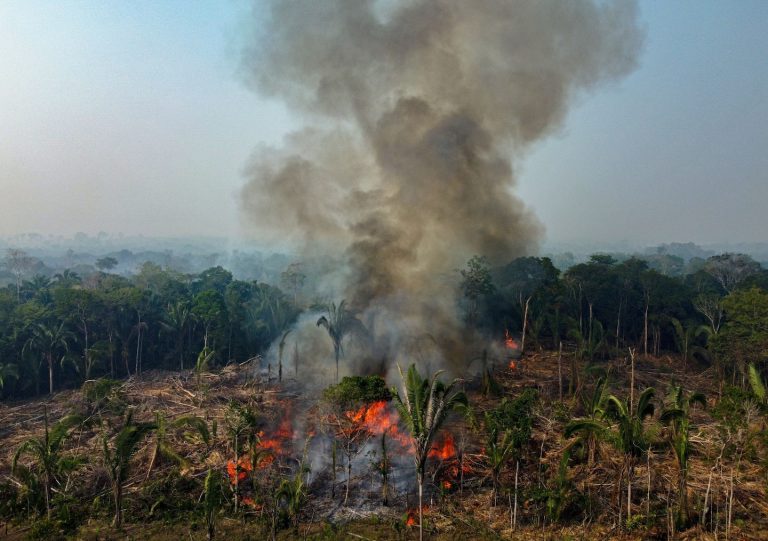A study published Wednesday in the journal Nature says that by 2050, between 10 and 47 percent of forests are expected to reach critical thresholds for rising temperatures, severe drought, deforestation and fires. The ensuing ecosystem shifts could accelerate global warming by releasing stored carbon into the atmosphere, the researchers wrote.
“At the end of this process, our planet will reorganize itself and find a new balance,” Bernardo M. Flores, the study’s lead author, said in an email. He added that “humans and other species will have to adapt to very unpleasant conditions,” such as “unbearable drought” or high temperatures.
The peer-reviewed study is the first comprehensive look that combines several metrics to document Amazon degradation.
The study's authors list five critical thresholds, or tipping points, that should not be crossed, including keeping global warming below 2 degrees Celsius, or 3.6 degrees Fahrenheit, compared to pre-industrial levels (one of the goals set in the 2015 Paris Agreement). , keeping annual rainfall in the Amazon above 1,000 millimeters and containing deforestation to 20 percent.
However, the study authors recommended stricter limits that they refer to as “safe” limits: 1.5 degrees Celsius (2.7 degrees Fahrenheit), 1,800 millimeters of annual rainfall and deforestation levels below 10 percent.
“When a forest reaches a tipping point, it becomes very difficult, if not impossible, to control the variables that cause it to shift,” Flores said. The result is a degraded ecosystem with fewer resources for local people, reduced rainfall and increased greenhouse gases, he said. He said humans must limit global warming and end Amazon deforestation to prevent it.
The Amazon rainforest has long had a net cooling effect on the planet, through a process scientists call evapotranspiration. Amazon water near the Atlantic coast evaporates into the air and floats inland before turning into rain. The same moisture evaporates again, floating inward before repeating the process, spreading the water deeper and deeper throughout the Amazon.
The Amazon forests contain up to 200 billion metric tons of carbon, the equivalent of 15 to 20 years of global emissions.
But the ability of the Amazon forest to act as a natural shield against global warming is gradually diminishing due to recurring droughts and rising temperatures caused by human activities such as logging, livestock farming and fires.
About 17% of what remains of the Amazon today “has been degraded by human disturbance,” the authors write. When including the impact of recent recurring droughts, about 38% of rainforests may have been degraded, they added.
The Washington Post reported that the Amazon region was subjected to droughts in 2005, 2010, 2015, 2016, 2020, and last year. The frequency of major droughts has accelerated from once every 20 years to twice every decade.
Erica Fleishman, director of the Oregon Institute for Climate Change Research at Oregon State University who was not involved in the study, said the latest research “effectively highlights that the interaction between climate change and land use can have significant and lasting environmental impacts,” although not necessarily Catastrophic or irreversible.
Destruction of the Amazon forest would likely harm the forest's ability to “sequester carbon and mitigate global climate change,” she said in an email.
To slow or reverse this trend, South American governments must reduce deforestation and encourage restoration of degraded areas, especially in Brazil, the researchers wrote. “Up to a third of the total annual rainfall in the Amazon territories of Bolivia, Peru, Colombia and Ecuador depends on water coming from the Brazilian part of the Amazon forest.”
Carlos Nobre, one of the study's authors and an Earth systems scientist at the Institute for Advanced Studies at the University of São Paulo in Brazil, was among the first academics in the early 1990s to suggest that the Amazon would reach a tipping point, becoming a populated area. The degraded ecosystem resembles vast grasslands.
In an email, Nobre said he has become increasingly confident that Brazil and its neighbors will eliminate deforestation by 2030, pointing to a slowdown in deforestation last year documented by the Brazilian government and the Amazon Conservation Society, an advocacy group in the capital.
“We have to get to zero deforestation and forest degradation very soon, and we appear to be heading in that direction,” he said.
But Nobre and Noah Diffenbaugh, a professor of Earth system science at Stanford University, who was not involved in the study, expressed concern about humans succeeding in keeping temperatures below 1.5 degrees Celsius, a reference to how temperatures in 2023 will fluctuate near the threshold.
“Given that we just spent one year at 1.5°C[elsius] “As annual greenhouse gas emissions continue to rise, there is a real risk that long-term global warming will exceed those limits,” Diffenbaugh said in an email.

